 W
WThe Abana was a sailing barque wrecked at Blackpool in England on 22 December 1894.
 W
WMV Algocape was a Canadian lake freighter operated by Algoma Central Corp. Initially constructed for Canada Steamship Lines as Richelieu, the ship was sold to Algoma Central Corp in 2004 and renamed Algocape. In 2012, the ship was sold again to Dido Steel Corporation and renamed Goc.
 W
WAlgoma Progress was a self-unloading lake freighter and bulk carrier operating on the North American Great Lakes, owned by Algoma Central. Launched in 1968, the ship was originally named Canadian Progress and operated by the Upper Lakes Shipping. At launch, the ship was the largest self-unloading vessel on the Great Lakes. Canadian Progress was used to transport coal, iron ore, barley and road salt on the Great Lakes and Saint Lawrence Seaway. Canadian Progress ran aground twice, the first in 1985 and then again in 1988. In 2011, Upper Lakes Shipping sold its entire fleet to Algoma Central, which renamed the vessel Algoma Progress. In 2014, Algoma Progress was sold for scrap and broken up at Port Colborne, Ontario.
 W
WThe Algonorth (1) was a seawaymax lake freighter built in 1970 by the Govan Division of Upper Clyde Shipbuilders Ltd. in Govan, Scotland. Her original owners were Lambert Bros. Shipping Ltd., of London, England, where she was known as the Temple Bar.
 W
WMV Αrmenistis is a ferry in service in Greece. She was built in 1971 as Anderida for Stena Line, serving under charter with Sealink until 1980. She then served under the names Truck Trader, Sealink and Mirela before she was sold to the Coopérative de Transport Maritime et Aérien (CTMA) in 1986 and renamed C.T.M.A. Voyageur. In January 2020 it was announced that the ship was sold to the Greek company AINAFTIS. Her new name is Armenistis.
 W
WThe steamship Bannockburn was a Canadian registered steel-hulled freighter which disappeared on Lake Superior in snowy weather on November 21, 1902. She was sighted by the captain of a passing vessel, the SS Algonquin, around noon of that day but minutes later disappeared. The wreck of the ship has never been found, with the exception of an oar and a life preserver, and no bodies were ever recovered. Within a year of her disappearance she acquired a reputation as a ghost ship and became known as The Flying Dutchman of the Great Lakes.
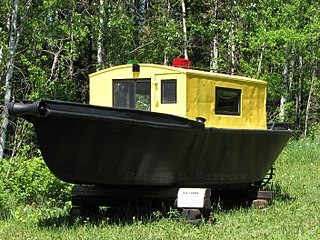 W
W'Brompton Caribou' is 28 feet 6 inches long, 7 feet 6 inches wide and has a depth of 2 feet 9 inches boat commonly known as a "Gator Tug", or "Winch boat" made by the Russel-Hipwell Engines Company in 1955 and is hull number 1058. It is made with a welded 3/16" steel hull in the clinker configuration and a cabin made of 18 gauge steel. It has a cable steering system with a plate steel rudder, 26" diameter Propeller with a rather heavy duty shield around the prop made of round bar to shop logs and debris from damaging the propeller, English made Lister model FR4 4 cylinder water-cooled diesel engine producing 36 hp at 1,800 rpm and a Twin Disc model MG-61 reversing marine gearbox with a 3:1 gear ratio. This boat also originally had a Russel-Hipweel winch, model W-434 that was driven by a PTO on the front of the engine but it has since been removed. The standard models have a simple rectangle cabin with a large sliding windows on both the port and starboard sides, a smaller sliding window and a door that opens to the inside on the front, and a little sliding door on the back of the cabin. They usually have the exhaust pipe going out through the side of the hull approximately a foot below the bulwarks on an angle facing aft, but many have had the pipe removed and installed going up through the roof of the cabin.
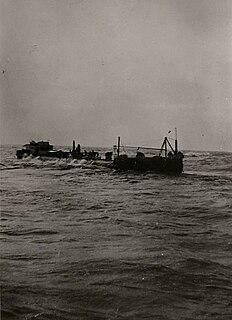 W
WBruce Hudson was an oil tanker which mainly carried petroleum products on the North American Great Lakes. She was built in 1935 by the Horton Steel Works Ltd. of Fort Erie. Originally Bruce Hudson, and sister ships, were unpowered tank barges, that relied on tugboats to tow them from port to port. This did not prove very workable. In July, 1935, Bruce Hudson capsized in high seas off Cobourg, Ontario, while being towed from Montreal to Port Credit, Ontario, with a load of crude oil. She was towed upside-down to St. Catharines, Ontario, siphoned out, righted, and returned to service. In November 1935, the crew of Bruce Hudson were removed from the barge in high seas, again off Cobourg, when the tug Ethel ran low on fuel and had to leave the vessel adrift on Lake Ontario. The steamer Brulin took the barge in tow and won salvage fees in Exchequer Court of Canada.
 W
WMV Camilla D is a St Kitts and Nevis cargo vessel that has operated since 2003 in the waters of eastern and Arctic Canada. Before that, the ship was sailing under the Finnish flag as MS Camilla, owned by Lundqvist Rederierna of Mariehamn, Åland Islands. The ship was built by Krögerwerft GmbH in Rendsburg, West Germany in 1982. As the ship operated out of Finnish and Baltic ports in winter mainly without icebreaker assistance, she has the highest Finnish-Swedish ice class of 1A Super.
 W
WSS Cantabria was a Spanish cargo ship which was sunk in a military action of the Spanish Civil War, off the coast of Norfolk 12 miles ENE of Cromer on 2 November 1938. The ship was shelled by the Spanish Nationalist auxiliary cruiser Nadir, which was part of General Franco's navy.
 W
WThe City of New York was a steam barquentine best known for being Richard E. Byrd's flagship on his 1928–30 exploration of Antarctica, mistakenly for the rescue of Shackleton in 1915, and most infamously for possibly being the ship that failed to come to the aid of the Titanic in 1912. Her name was changed several times; originally named Samson (1885–1914), she was renamed the Jacobsen (1915–1919), and then the Belsund (1919–1926), and back to Samson (1926–1928), before being finally dubbed the City of New York in 1928.
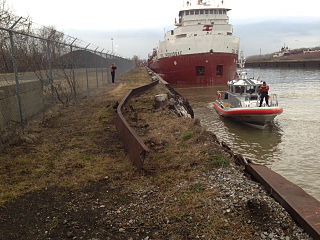 W
WCSL Tadoussac is a lake freighter currently operated by Canada Steamship Lines (CSL) on the Great Lakes. She was launched in 1969. Initially named Tadoussac, following her refit in 2001, she was renamed CSL Tadoussac She was the last freighter built for CSL in the traditional two superstructure design, which puts her bridge up in the ship's bow. The vessel primarily transports iron ore and coal.
 W
WEmpire Engineer was a 5,358 GRT refrigerated cargo ship that was built in 1921 as Canadian Commander by Canadian Vickers Ltd, Montreal, Quebec, Canada. She was sold to an Italian firm in 1932 and renamed Giaocchino Lauro. She was seized by the United Kingdom in 1940, passed to the Ministry of War Transport (MoWT) and renamed Empire Engineer. She served until 4 February 1941 when she was torpedoed and sunk by U-123.
 W
WEmpire Sandy is a tall ship providing chartered tours for the public from Toronto, Canada. She was built as an Englishman/ Larch Deep Sea-class tugboat for war service by the British government in 1943. After the end of World War II she was renamed Ashford and then Chris M before reverting to the original name of Empire Sandy and being converted to a schooner.
 W
WEnglish River is a Canadian lake freighter and bulk carrier, launched in 1961. In her initial years she carried bulk cargoes and deck cargoes to smaller ports on the Great Lakes and Saint Lawrence River watershed and estuary. Her cargo capacity is about a quarter that of most of the Great Lakes fleet, she is slightly more than half the length, and her draught is about two-thirds that of larger vessels.
 W
WFort Victoria was a 7,784 GRT cruise ship which was built in 1912 as Willochra. During the First World War she was requisitioned for use as a troopship. In 1920 she was sold and renamed Fort Victoria, serving until lost in a collision in 1929.
 W
WMV Fundy Rose is a RORO passenger ship owned by the Government of Canada, which entered service with Bay Ferries in 2015 between Saint John, New Brunswick, and Digby, Nova Scotia, replacing the MV Princess of Acadia. The vessel is formerly owned by Attica Group based in Athens, Greece, and was operated under the name Blue Star Ithaki by their subsidiary company Blue Star Ferries under the Greek flag.
 W
WThe George M. Carl was a lake freighter with 10,000 ton displacement.
 W
WSS Ithaka was a small freighter, originally built as Frank A. Augsbury for the Canadian George Hall Coal & Shipping Corporation in 1922. She went on to sail for a variety of different owners, and was renamed Granby in 1927, Parita II in 1948, Valbruna in 1951, Lawrencecliffe Hall in 1952, Federal Explorer in 1955 and finally Ithaka in 1960, before being wrecked on the Canadian coast later that year.
 W
WThe J.H.G. Hagarty was a 550-foot (170 m) Canadian Great Lakes freighter that served from her launching in 1914 to her scrapping in 1968. The Hagarty was used to haul bulk cargoes such as iron ore, coal, grain and occasionally limestone. She had a length of 550-feet, a beam of 58-feet and a height of 31-feet. She was powered by a 2,400 horsepower triple expansion steam engine and fueled by two coal-fired Scotch marine boilers.
 W
WThe SS Keno is a preserved historic sternwheel paddle steamer and National Historic Site of Canada. The SS Keno is berthed in a dry dock on the waterfront of the Yukon River in Dawson City, Yukon, Canada.
 W
WThe steamship Kerry Range was a 5,800-ton general cargo freighter, armed with 4.7-inch (119 mm) guns, that had been built by the Northumberland Shipbuilding Company and launched on 27 November 1915. While serving as a Royal Navy armed transport she was damaged in a fire, with loss of life, in Baltimore, Maryland, in October 1917. Investigating officials, after the fire, were convinced the vessel was the target of arson, and that the arsonists were German agents—an enemy of the United Kingdom and the United States, during World War I. Several suspects were arrested. However, it was later determined that the fire on Pier 9, that triggered the fire on board Kerry Range, was due to an electrical malfunction that triggered oakum, a flammable product once used to pack seams on ships. Three crew members lost their lives. Firefighting officials towed the blazing vessel away from the pier, to help prevent it igniting nearby Pier 8, and scuttled her. It took over a day to completely put out the fires on the hulk. Some press reports at the time wrote she was a complete write-off. However, the damaged vessel was salvaged and sold to the Steam Navigation Company of Canada in 1918.
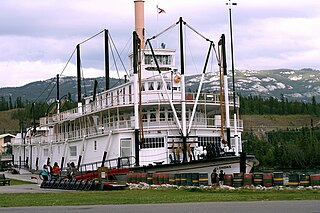 W
WSS Klondike was the name of two sternwheelers, the second now a national historic site located in Whitehorse, Yukon, Canada. They ran freight between Whitehorse and Dawson City along the Yukon River, the first from 1929-1936 and the second, an almost exact replica of the first, from 1937–1950.
 W
WLe Griffon was a sailing vessel built by René-Robert Cavelier, Sieur de La Salle in 1679.
 W
WLiana's Ransom is a Pirate party vessel, operated from Nova Scotia.
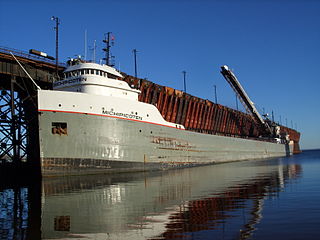 W
WMichipicoten is a self-discharging lake freighter owned and operated by Canadian shipping firm Lower Lakes Towing. Michipicoten primarily hauls taconite from Marquette, Michigan to the Algoma Steel Mill in Sault Ste. Marie, Ontario. It has a capacity of 22,300 tons, a speed of 12 knots (14 mph), and a length of 689 feet 6 inches (210.2 m).
 W
WPolar Chief was an 8,040 GRT tanker which was built in 1897 as the cargo ship Montcalm. In 1914 she was requisitioned by the Admiralty, serving initially as a troopship. In October 1914, she was converted to a dummy battleship and renamed HMS Audacious. In 1915 she became a depot ship, followed by conversion to a tanker in 1916 when she was sold into Royal Fleet Auxiliary service and renamed RFA Crenella. In 1917, she survived a torpedo attack off the coast of Ireland. In 1919, she was sold into merchant service as SS Crenella.
 W
WRadcliffe R. Latimer is a lake freighter launched in 1978. The vessel is owned by Algoma Central but operated under charter to Canada Steamship Lines from 1994 to 1997. As Algobay, the bulk carrier was involved in a collision with another lake freighter in 1980. In 2009 the vessel was rebuilt in China for service in the Caribbean Sea. The vessel is currently in service.
 W
WThe SS Regina was a steel canaler built for the Merchant Mutual Line and home ported in Montreal, Quebec. Named after Regina, Saskatchewan, Regina had a tonnage of 1,956 gross register tons (GRT) and a crew of 32.
 W
WSS Royal William was a Canadian side-wheel paddle steamship that is sometimes credited with the first crossing of the Atlantic Ocean to be made almost entirely under steam power, in 1833, using sails only during periods of boiler maintenance, though the British-built Dutch-owned Curaçao crossed in 1827, and the sail-steam hybrid SS Savannah used some steam power when crossing in 1819. She was the largest passenger ship in the world from 1831 to 1839.
 W
WUSS Scourge was an American warship converted from a confiscated Canadian merchant schooner. She foundered along with the American warship Hamilton during a squall on Lake Ontario at 2:00am on Sunday, August 8, 1813,. during the War of 1812.
 W
WSedna Desgagnes is a bulk carrier built, in China for the Canadian shippling line Groupe Desgagnés. The television series High Arctic Haulers followed the vessel as she made the annual deliveries of supplies to a series of communities in Canada's Arctic Archipelago, during the short shipping season.
 W
WFor other ships of this name, see Sweepstake (disambiguation)
 W
WThe Thalassa Desgagnes is a double-hulled tanker operated by Groupe Desgagné. She was launched on 19 December 1975 and completed in 1976 by Ankerlokken Glommen in Norway.
 W
WMV Tim S. Dool is an Algoma Central-owned seawaymax lake freighter built in 1967, by the Saint John Shipbuilding and Dry Dock Co. in Saint John, New Brunswick. She initially entered service as Senneville when she sailed as part of the fleet of Mohawk Navigation Company. Senneville was the second lake freighter constructed with a single superstructure at the stern. In 1981, the ship was sold to Pioneer Shipping. That company sold the vessel to Algoma Central in 1994 who renamed the ship Algoville. The bulk carrier got her current name in 2008. Tim S. Dool is currently in active service on the Great Lakes of North America.